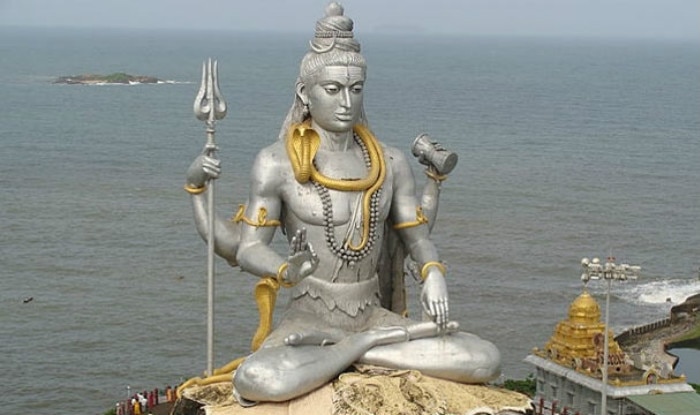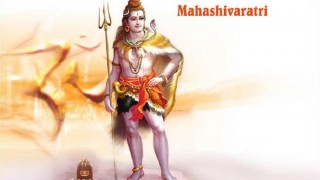

Here are 9 interesting facts about Lord Shiva:
1. His attire:

Lord Shiva is often represented with a snake named Vasuki, coiled around his neck. The snake represents the fact that he controls death and fear. A crescent moon adorns his hair as Holy River Ganga flows out from his head. The cresent moon represents the time cycle. Trishul or his trident is an important part of his identity that he uses as his weapon. The three spikes represent the three gunas such as sattva, rajas and tamas. Sattva is the basis of creation while rajas stand for continuity and Tamas is the base of destruction. The damru is his musical instrument of choice. The objects that Lord Shiva carries in his hands signify five elements that project the Lord as the Supreme head of creation.
2. 108 Names:

From Mahadev, Neelkantha and Shiva to Mahakaal, Shrikanth, Triolokesh, Lord Shiva has more than 108 names. Interestingly, each of his names highlights a special attribute or a quality or a mythological event. Lord Shiva is prayed to as the creator, preserver as well as the destroyer of our world. The number 108 is considered to be an important number in Hinduism.
3. Calm and Furious:

The mountains, snow and the snake around Lord Shiva’s neck is a symbol representing his sense of calmness. He is considered to be a sign of calm and peace. At the same time, we all know about the anger of Lord Shiva. It is believed that Lord Shiva took the form of Nataraja and performed the famous Tandava or the dance of destruction to crush the arrogant Apasmara under his right foot. Shiva’s Nataraja avatar is a message that ignorance can only be overcome with knowledge, music, and dance.
4. Ashes and the Third Eye:

The three horizontal lines of ash on Lord Shiva’s forehead refer to the destruction of the three worlds of Hinduism. Another attribute that sets lord Shiva apart is the presence of the third eye on his forehead. The third eye represents the future. Therefore He is viewed as the Lord of all three times – past, present and future. Two eyes stand for sun and moon, the third eye stands fo Agni or fire.
5. Cannabis:

On Shivaratri, the Shaivites, a sect of followers, consume Bhang (a beverage prepared from cannabis) and smoke weed. This offering is quite popular among followers. Mythylogy states that Lord Shiva does smoke Marijuana in various forms. But, in his defence, it is believed that this is purely to survive the climatic extremities of the mountains.
6. Ardhanareshwar:

Much like Lord Ram and Goddess Sita, Shiv-Parvati are also cited as an example of perfect marriage. Lord Shiva is represented in the Ardhanarishwar form – which is a half male and half female icon. It is often said that this androgynous form shows that the masculine energy (Purusha) and feminine energy (Prakrithi) of the universe in a synthesis.
7. Lord Shiva punished one crore gods:

Hindu mythology states that once, Lord Shiva was on his way to Kashi along with one crore gods and goddesses. And he asked all of them to wake up before sunrise the following day, before taking a night’s rest in Unakoti, Tripura. But in the morning, no one except Shiva woke up. Furious, Shiva set out for Kashi on his own, cursing the others to become stone images.
8. The legend of Ganga:

Mythology states that Bhagiratha asked Brahma to bring the river Ganges down to earth so that he could perform a ceremony for his ancestors. Brahma directed Bhagiratha to Lord Shiva, as only he could break Ganga’s landfall. The story goes that Ganga arrogantly flew down to earth but Shiva calmly trapped her back in his hair and let her out in small streams.
9. Shivling:

Shivling is a unique depiction of Lord Shiva. The shivling is so designed to indicate the formless aspect of Shiva. It says Lord Shiva is without a beginning and an end. Scriptures say Shivling is the origin and destination of the entire cosmos. The word Linga is made out of two sounds, namely ‘Li’ that stands for ‘Liyate’ or emergence and ‘Ga’ that denotes ‘Gamyate’ or the final destination. Mahashivratri 2018: Best Bhajans and Devotional Songs to Pray to Lord Shiva and Goddess Parvati on Shivratri
Mahashivratri is celebrated with fanfare and enthusiasm by the Hindu community across India and some parts of Nepal. The festival is celebrated in a different way across the country. In Southern Karnataka, children indulge in mischief and then ask for punishment (symbolic of Shiva punishing Brahma for lying). Meanwhile, Kashmiri Brahmins celebrate Lord Shiva’s marriage to Parvati by starting the celebrations 3-4 days before to the main festival. Reportedly, Mahashivratri is also celebrated in parts of West Indies which apparently over 400 temples across the country.




